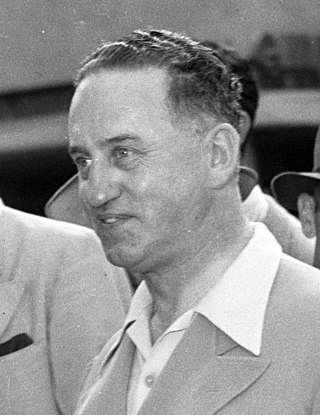
The Disney animators' strike was a 1941 American film industry work stoppage where unionized employees of Walt Disney Productions picketed and disrupted film production for just under four months.

The International Alliance of Theatrical Stage Employees, Moving Picture Technicians, Artists and Allied Crafts of the United States, Its Territories and Canada, known as simply the International Alliance of Theatrical Stage Employees, is a North American labor union representing over 168,000 technicians, artisans, and craftspersons in the entertainment industry, including live theatre, motion picture and television production, broadcast and trade shows in the United States, its territories, and Canada. It was awarded the Tony Honors for Excellence in Theatre in 1993.

Herbert Knott Sorrell was an American labor leader and Hollywood union organizer. He headed the Conference of Studio Unions (CSU) in the late 1940s, and was the business manager of the Motion Picture Painters union, Local 644 until the 1950s.

The United Brotherhood of Carpenters and Joiners of America, often simply the United Brotherhood of Carpenters (UBC), was formed in 1881 by Peter J. McGuire and Gustav Luebkert. It has become one of the largest trade unions in the United States, and through chapters, and locals, there is international cooperation that poises the brotherhood for a global role. For example, the North American Chapter has over 520,000 members throughout the continent.

The Minneapolis general strike of 1934 grew out of a strike by Teamsters against most of the trucking companies operating in Minneapolis, the major distribution center for the Upper Midwest. The strike began on May 16, 1934 in the Market District. The worst single day was Friday, July 20, called "Bloody Friday", when police shot at strikers in a downtown truck battle, killing two and injuring 67. Ensuing violence lasted periodically throughout the summer. The strike was formally ended on August 22.
The Animation Guild, IATSE Local 839, also known as The Animation Guild, or TAG is a professional guild and union of animation artists, writers and technicians. The full name of the organization is The Animation Guild and Affiliated Optical Electronic and Graphic Arts, Local 839 of the International Alliance of Theatrical Stage Employees and Moving Picture Technicians, Artists and Allied Crafts of the United States, its Territories and Canada, American Federation of Labor-Congress of Industrial Organizations/Canadian Labour Congress.
The set decorator is the head of the set decoration department in the film and television industry, responsible for selecting, designing, fabricating, and sourcing the "set dressing" elements of each set in a Feature Film, Television, or New Media episode or commercial, in support of the story and characters of the script. The set decorator is responsible for each décor element inside the sets, from practical lighting, technology, art, furniture, drapery, floor coverings, books, collectables, to exterior furnishings such as satellite dishes, Old West water troughs, streetlamps, traffic lights, garden furniture and sculptures.

The Art Directors Guild is a labor union and local of the International Alliance of Theatrical and Stage Employees (IATSE) representing 3,278 motion picture and television professionals in the United States and Canada.

From November 5, 2007 to February 12, 2008, all 12,000 film and television screenwriters of the American labor unions Writers Guild of America, East (WGAE), and Writers Guild of America West (WGAW) went on strike.
Bloody Friday is the name of an event which occurred in Minneapolis, Minnesota on July 20, 1934, when police shot at truck drivers injuring 67 picketers and killing strikers John Belor and Henry Ness. This was one incident in the Minneapolis general strike of 1934, beginning May 20 and ending on August 22.
The Kohler strikes at the Kohler Company, just west of Sheboygan, Wisconsin in 1934 and 1954, are landmarks in the history of both business and labor in the United States. Labor leaders have often cited the warfare at the giant plumbing supply company in their contention that workers need unions. Industrial leaders have pointed to the strikes as examples of union belligerence and indifference toward the true welfare of their employees.

The Screen Actors Guild-American Federation of Television and Radio Artists is an American labor union that reflects the 2012 merger of SAG and AFTRA. It represents approximately 160,000 media professionals worldwide. SAG-AFTRA is a member of the AFL-CIO, the largest federation of unions in the United States. SAG-AFTRA is also a member of the International Federation of Actors (FIA).

The Little Steel strike was a 1937 labor strike by the Congress of Industrial Organizations (CIO) and its branch the Steel Workers Organizing Committee (SWOC), against a number of smaller steel producing companies, principally Republic Steel, Inland Steel, and Youngstown Sheet and Tube Company. The strike affected a total of thirty different mills belonging to the three companies, which employed 80,000 workers. The strike, which was one of the most violent labor disputes of the 1930s, ended without the strikers achieving their principal goal, recognition by the companies of the union as the bargaining agent for the workers.

The 1992 Southern California drywall strike was a strike by Mexican and Mexican American drywall hangers, many of whom were undocumented, for fair wages and health insurance from contractors, who stole two billion dollars a years in income taxes, social security, and worker's compensation payments from the workers and collaborated with the local police to repress the organizers. Jesus Gomez, leader of the strike, received threats and had shots fired at his home, while key organizers were tailed by the police and even followed with helicopters. Eventually aligning with the United Brotherhood of Carpenters and Joiners, the strikers succeeded in getting union contracts that ensured fair wages and benefits. The strike left the residential construction industry in a different state. While the industry remained an open shop, contractors were forced to pay Mexican workers with wages and benefits closer to that of the white workers.
The Screen Cartoonist's Guild (SCG) was an American labor union formed in 1938 in Los Angeles, California. The SCG was formed in the aftermath of protests at Van Beuren Studios and Fleischer Studios, and represented workers and resolved issues at major American animation studios such as Walt Disney Productions.

The Detroit Newspaper Strike was a major labor dispute which began in Detroit, Michigan on July 13, 1995, and involved several actions including a local boycott, corporate campaign, and legal charges of unfair labor practices. The primary action involved around 2,500 members of six labor unions going on strike from July 13, 1995, to February 14, 1997. The unions ended their strike on February 14, 1997, and it was resolved in court three years later, with the journalists' union losing its unfair labor practices case on appeal.
The 1985–1987 Watsonville Cannery strike was a labor strike that involved over 1,000 workers at two food processing facilities in Watsonville, California, United States. The facilities were owned by Watsonville Canning and Richard A. Shaw Inc., two of the largest frozen food processors in the United States, while the workers were all union members of the International Brotherhood of Teamsters (IBT) Local 912. The strike began on September 9, 1985, and completely ended about 18 months later, on March 11, 1987.
The 1937 Fleischer Studios strike was a labor strike involving workers at Fleischer Studios in New York City. The strike commenced on May 7 of that year and ended on October 12. The strike was the first major labor dispute in the animation industry and resulted in the industry's first union contracts.
The 1982 animators' strike was a labor strike conducted by American animators in the Greater Los Angeles area. The strike, organized by the Motion Picture Screen Cartoonists Local 839, was caused by disagreements between the labor union and studios over runaway productions, a term referring to outsourcing production work to outside of the metropolitan area. The strike ran from August to October and ended in failure for the union, who failed to win concessions from the studios.

From May 2 to September 27, 2023, the Writers Guild of America (WGA)—representing 11,500 screenwriters—went on strike over a labor dispute with the Alliance of Motion Picture and Television Producers (AMPTP). With a duration of 148 days, the strike is tied with the 1960 strike as the second longest labor stoppage that the WGA has performed, only behind the 1988 strike. Alongside the 2023 SAG-AFTRA strike, which continued until November, it was part of a series of broader Hollywood labor disputes. Both strikes contributed to the biggest interruption to the American film and television industries since the COVID-19 pandemic.












